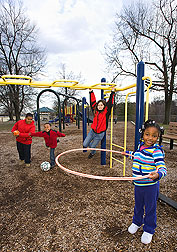Weight Gains in U.S. Hispanic Children
Study Identifies Significant Predictors
|
|
Kids who have the highest risk of gaining excess weight might be identified reliably, thanks to a set of scientifically sound predictors.
Nancy F. Butte, a professor of pediatrics at the ARS Children’s Nutrition Research Center at Baylor College of Medicine in Houston, Texas, led a team that found statistically significant associations between weight gains and several measurable factors. The team worked with volunteers—879 Hispanic kids, preteens, and teens, age 4 to 19, from the greater Houston area. They were participants in Viva La Familia, an ambitious investigation of what’s causing obesity among America’s Hispanic kids and what might be done to prevent or treat it.
The weight-gains study was “the first to provide definitive predictors of excess weight gains for the Hispanic population,” Butte says. Positive predictors of weight gain, as reported by Butte and co-investigators in the American Journal of Clinical Nutrition, are:
• child’s BMI, or body mass index. The heavier the child, the more likely a gain.
• mother’s BMI. Gains are more likely with heavier mothers.
• levels of the hormones insulin, ghrelin, leptin, or thyroid, measured in a fasting blood sample. Higher values are associated with higher gains.
• calories burned in a day. Perhaps surprisingly, the higher the energy expended, measured while asleep or awake, the higher the gain.
|
|
Butte collaborated in the research with Kenneth J. Ellis and Theresa A. Wilson at the Houston center; Jennifer O. Fisher, Temple University, Philadelphia, Pennsylvania; Issa F. Zakeri, Drexel University, also in Philadelphia; Guowen Cai, SAS Institute, Inc., Cary, North Carolina; and Shelley A. Cole and Anthony G. Comuzzie of the Southwest Foundation for Biomedical Research, San Antonio, Texas.
The weight-gain predictors are “meant to shed light on the causes of childhood obesity and to help identify those children who are at increased risk for excess weight gain,” says Butte. “Mindful weight management may help at-risk kids reduce their chances of developing obesity-related illness, including type 2 diabetes and cardiovascular disease, later in life.”—By Marcia Wood, Agricultural Research Service Information Staff.
This research is part of Human Nutrition, an ARS national program (#107) described at www.nps.ars.usda.gov.
Nancy F. Butte is with the USDA-ARS Children’s Nutrition Research Center at Baylor College of Medicine, 1100 Bates St., Houston, TX 77030; (713) 798-7179.
"Weight Gains in U.S. Hispanic Children" was published in the March 2010 issue of Agricultural Research magazine.








